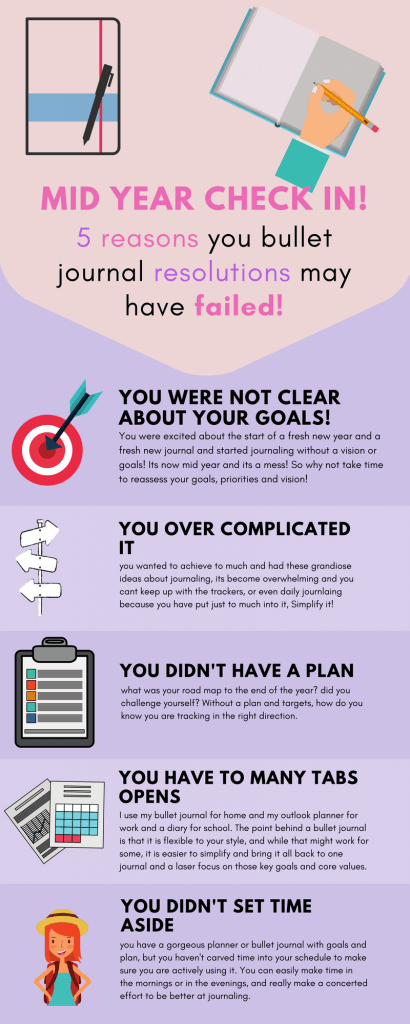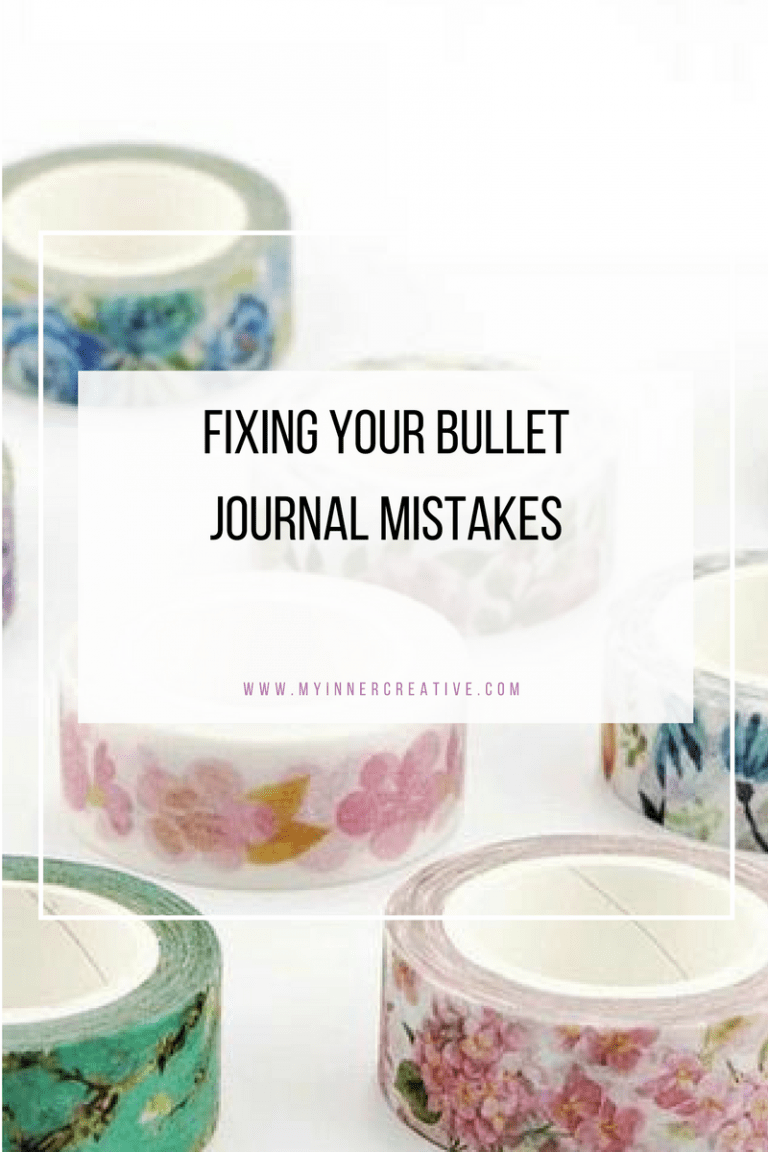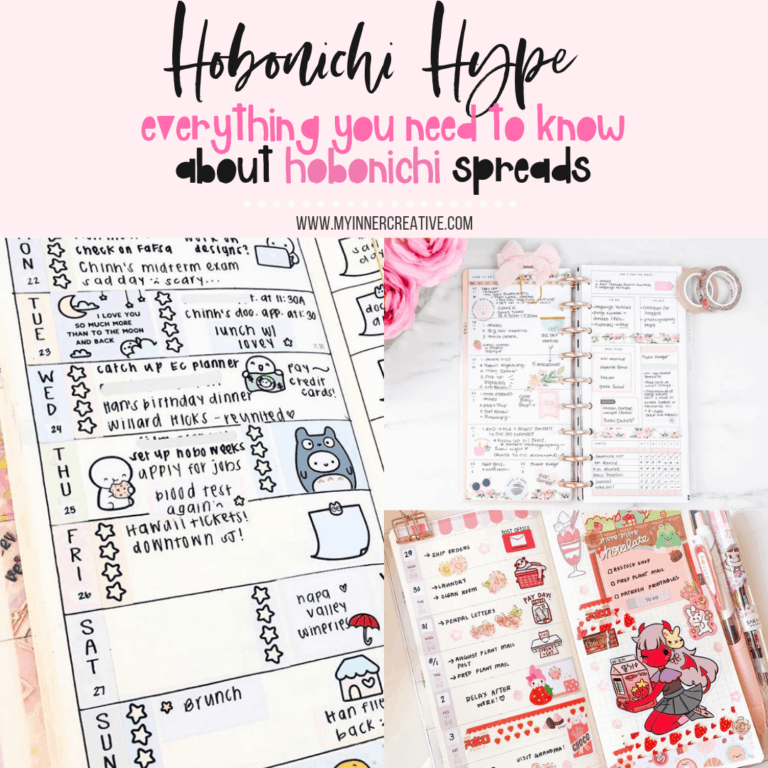Why you might fail at using a bullet journal
REASON #1: I dont know what I want to put in my bullet journal
REASON #2: Don’t over complicate your first bullet journal
REASON #3: Plan out what you want in your bullet journal
REASON #4: you aren’t sure how to transition to a bullet journal from a calendar or planner
REASON #5: I dont know how to make time to bullet journal
Working on a planner doesn’t have to be an all time consuming task.
But I believe that everybody is capable of finding five minutes of their time to review the day ahead. Whether it’s jotting down a few notes about your day, or writing out a to do list, you can find a little time to do something.
If you are only working on it once a week, it may explain why you struggle with bullet journals. So simplify if you’re doing too much. Start small, and work from there. I work on the SAVERS/AVID programme, where I scribe in the morning and reflect at night. ife can be busy, and finding time for new activities can feel challenging. However, incorporating bullet journaling into your routine doesn’t have to be an overwhelming commitment. Even dedicating just five minutes a day can yield significant benefits. Consider integrating your journaling time into existing habits. Set aside a few minutes before bed or during your morning routine to review your day or plan ahead. Use this time to jot down thoughts, tasks, or reflections. Gradually, you may find that these short journaling sessions become a valuable and rewarding part of your daily routine.
Starting and maintaining a bullet journal can be a transformative experience, but it’s common to face challenges along the way. By addressing these five reasons for potential failure, you can overcome obstacles, adjust your approach, and unlock the full potential of bullet journaling as a tool for organization, productivity, and personal growth. Remember, your bullet journal journey is unique to you, and it’s about progress, not perfection.
What about some other reasons you might fail at your bullet journal?
Reason 1: Lack of Clarity in Purpose
A bullet journal can be a powerful tool, but its effectiveness hinges on a clear and well-defined purpose. Without a sense of direction, your journal might become a disorganized collection of scattered thoughts and unfinished plans. Let’s delve into the significance of having a purpose for your bullet journal, the pitfalls of not doing so, and how to navigate this challenge successfully.
The Importance of Having a Clear Purpose
A bullet journal is more than just a notebook filled with tasks and doodles. It’s a personalized system designed to help you achieve your goals, stay organized, and foster mindfulness. Establishing a clear purpose for your journal is akin to setting the foundation for a successful journey. When you have a specific reason for using your journal, it becomes a strategic tool rather than a mere pastime.
The Dangers of Undefined Goals and Intentions
Imagine entering a dense forest without a map or compass; you’d quickly lose your way and struggle to find your destination. Similarly, not defining your goals and intentions for your bullet journal can lead to confusion and disarray. Without a roadmap, your efforts might be scattered across various pages, making it difficult to track progress, prioritize tasks, or gain insights from your entries.
Examples of Specific Purposes for Bullet Journaling
Bullet journaling can serve a multitude of purposes, tailored to your individual needs and aspirations:
- Daily Planning: Many individuals use bullet journals to outline their daily tasks, appointments, and commitments. Having a dedicated space to jot down to-do lists and schedules can lead to enhanced time management and productivity.
- Habit Tracking: Bullet journals are excellent tools for tracking habits. Whether you’re aiming to exercise regularly, meditate, or read more books, a habit tracker can help you monitor your progress and establish positive routines.
- Goal Setting: Setting and tracking goals within your bullet journal can provide a sense of direction and motivation. Whether your goals are related to personal growth, career advancement, or creative endeavors, a bullet journal can serve as a visual representation of your journey.
- Project Management: If you’re juggling multiple projects or tasks, your bullet journal can help you break them down into manageable steps. From brainstorming ideas to tracking milestones, your journal can be your project management companion.
Tips for Identifying Your Purpose and Aligning Your Approach
- Reflect on Your Needs: Take time to introspect and identify what areas of your life need organization and improvement. Are you struggling with time management, creativity, or personal growth? Your purpose should align with addressing these needs.
- Set Clear Goals: Define specific goals you want to achieve through bullet journaling. Do you want to complete tasks more efficiently, build healthy habits, or track progress on your creative projects? Having clear goals will guide your journaling efforts.
- Start Small: If you’re unsure about your purpose, start small. Begin with basic daily planning or habit tracking. As you gain confidence and clarity, you can expand your journal’s scope.
- Experiment and Adjust: Your purpose might evolve over time, and that’s perfectly fine. Experiment with different layouts and techniques to see what resonates with you. Don’t be afraid to make adjustments as needed.
- Stay Mindful and Adaptable: Your bullet journal is a reflection of your journey. Stay mindful of your changing needs and adapt your approach accordingly. Embrace the flexibility to try new methods and refine your journaling style.
A lack of clarity in purpose can undermine the effectiveness of your bullet journal. By defining your goals, intentions, and areas of focus, you can transform your journal into a dynamic tool that empowers you to achieve your objectives. Whether it’s daily planning, habit tracking, goal setting, or project management, align your journaling approach with your unique needs and aspirations for a more organized and intentional life.
Reason 2: Overcomplication and Perfectionism
Bullet journaling has gained popularity not only for its functionality but also for its creative potential. However, there’s a fine line between enhancing your journal with creativity and falling into the trap of overcomplication and perfectionism. Let’s explore how these tendencies can hinder your bullet journaling experience, and how to strike a balance between aesthetics and practicality.
The Pitfalls of Overcomplication and Perfectionism
While it’s natural to want your bullet journal to look aesthetically pleasing, the pursuit of perfection can inadvertently lead to frustration and even abandonment of the practice. Overcomplicating layouts and designs can make journaling feel like a daunting task, especially when you spend more time beautifying the pages than actually utilizing them. This can deter you from maintaining a consistent journaling habit.
The Perfectionism Paradox
Perfectionism is the tendency to set unrealistically high standards for oneself and feel discontent when those standards aren’t met. In the context of bullet journaling, perfectionism can manifest in multiple ways. You might find yourself spending excessive time selecting the perfect colors, fonts, and decorations for each page, rather than focusing on the content and functionality. This can lead to feelings of inadequacy and overwhelm.
Guidance on Keeping Layouts Simple
It’s crucial to strike a balance between creating visually appealing spreads and maintaining the practicality of your bullet journal. Here are some tips to avoid falling into the overcomplication and perfectionism trap:
- Prioritize Functionality: Remember that the primary purpose of your bullet journal is to enhance your organization, productivity, and mindfulness. Prioritize functionality over aesthetics. Choose layouts and designs that serve your needs effectively.
- Start Simple: If you’re new to bullet journaling, start with basic layouts and designs. As you become more comfortable with the process, you can gradually introduce creative elements.
- Embrace Minimalism: Minimalistic designs can be just as impactful as intricate ones. Focus on clean lines, clear headings, and uncluttered spaces. This approach not only makes your journaling experience smoother but also reduces the pressure to create complex spreads.
- Limit Color and Decoration: While colors and decorations can add flair to your journal, avoid going overboard. Select a limited color palette and use decorations sparingly to maintain a cohesive and organized look.
Personal Anecdotes and Case Studies
Sometimes, the best way to drive home a point is through real-life examples:
Sarah’s Story: Sarah was enthusiastic about bullet journaling but found herself spending hours on elaborate page designs. Her perfectionism was so paralyzing that she often left pages blank, fearing that her efforts wouldn’t meet her high standards. As a result, her journal became a source of stress instead of the productivity tool she intended it to be. Over time, Sarah realized the importance of prioritizing functionality and gradually shifted her focus from aesthetics to practicality. This change allowed her to experience the true benefits of bullet journaling.
Michael’s Journey: Michael, a creative professional, was excited to infuse his bullet journal with his artistic talents. However, his desire for perfection led him to spend excessive time on intricate illustrations and elaborate layouts. This left him frustrated and drained, causing him to neglect his journal altogether. After discovering the concept of minimalism in bullet journaling, Michael embraced simplicity. He focused on clean designs that complemented his need for organization, ultimately rekindling his enthusiasm for journaling.
While creativity has its place in bullet journaling, overcomplicating layouts and giving in to perfectionism can hinder the very benefits you seek. The key is to strike a balance that aligns with your personal goals and priorities. Remember that a bullet journal is a tool for your growth, organization, and self-expression. By keeping layouts simple and focusing on functionality, you’ll find that your journal becomes a more valuable and sustainable companion on your journey.
Reason 3: Inconsistent Routine and Commitment
Consistency is the backbone of any successful endeavor, and bullet journaling is no exception. The power of a bullet journal lies not only in its creative potential but also in its ability to help you stay organized, track your progress, and foster mindfulness. Inconsistent routines and lack of commitment can undermine these benefits and hinder your overall journaling experience. Let’s explore why consistency is crucial, the pitfalls of irregular journaling, and effective strategies to establish and maintain a journaling routine.
The Importance of Consistency in Using a Bullet Journal
Consistency is the cornerstone of habit formation and goal achievement. When you engage in a routine, your mind and body become accustomed to the task, making it easier to repeat over time. In the context of bullet journaling, consistency transforms journaling from a sporadic activity into a reliable tool that supports your daily life. Regular journaling enables you to track your tasks, events, and reflections consistently, providing you with a comprehensive overview of your progress and priorities.
The Dangers of Inconsistency
Inconsistent journaling can lead to a cascade of challenges:
- Missed Tasks: If you don’t consistently update your journal, you might forget to record important tasks or events. This can lead to missed deadlines and opportunities.
- Incomplete Tracking: Inconsistent tracking makes it difficult to monitor your habits, progress, and goals effectively. This lack of data hampers your ability to make informed decisions.
- Lack of Progress: A bullet journal is designed to help you track your growth and accomplishments over time. Inconsistent use can obscure the positive changes you’ve made, leading to a perception of stagnation.
Practical Strategies for Establishing a Journaling Routine
- Set Specific Times: Dedicate specific times each day or week for journaling. This could be in the morning before starting your day, during a break, or before bed. Consistency becomes easier when journaling becomes a natural part of your routine.
- Use Reminders: Set reminders on your phone or calendar to prompt you to journal. These gentle nudges can help you develop the habit until it becomes second nature.
- Start Small: If daily journaling feels overwhelming, start with a more manageable frequency, such as journaling every other day or a few times a week. As you build consistency, you can gradually increase the frequency.
- Create Rituals: Pair your journaling with an existing habit or ritual. For example, you can journal while enjoying your morning coffee or after you finish your workout.
Highlighting the Positive Outcomes of Consistent Journaling
Consistency isn’t just about ticking off tasks; it’s about reaping the rewards of an organized and intentional life:
- Increased Productivity: Regularly updating your bullet journal helps you stay on top of tasks, deadlines, and commitments. This leads to improved time management and heightened productivity.
- Enhanced Reflection: Consistent journaling provides you with a space to reflect on your achievements, challenges, and lessons learned. This introspection promotes personal growth and self-awareness.
- Mindfulness and Stress Reduction: The act of journaling encourages you to be present and mindful. This can alleviate stress and anxiety as you document your thoughts and emotions.
Inconsistent routine and commitment can hinder the potential benefits of bullet journaling. By recognizing the importance of consistency and its positive impact, you can transform your journal from a sporadic activity into a powerful tool for organization, self-improvement, and mindfulness. Remember that building a routine takes time, and setbacks are natural. Be patient with yourself and keep your eyes on the long-term rewards that consistent journaling can bring to your life.
Reason 4: Unrealistic Expectations
In the world of bullet journaling, as with any endeavor, setting realistic expectations is key to a fulfilling and sustainable journey. Often, individuals approach bullet journaling with high hopes of instant transformation, envisioning perfectly organized lives and profound shifts in productivity. However, when these unrealistic expectations are not met, disappointment can set in. Let’s delve into the issue of unrealistic expectations in bullet journaling, the pitfalls of expecting too much too soon, and how to cultivate a more balanced and achievable perspective.
The Allure of Instant Transformation
In an age of instant gratification, it’s natural to desire immediate results from new practices like bullet journaling. However, when people enter the bullet journaling world with the expectation that their lives will magically become perfectly organized, their unrealistic hopes can set them up for disappointment.
The Disappointment of Unrealistic Expectations
Unrealistic expectations can lead to several negative outcomes:
- Frustration: When your bullet journal doesn’t instantly transform your life, frustration can set in. The disparity between expectations and reality can create a sense of failure.
- Abandonment: Disappointment can lead to the abandonment of the practice altogether. If you believe bullet journaling isn’t working as you envisioned, you might conclude that it’s not worth the effort.
- Self-Criticism: Unrealistic expectations can foster negative self-talk. You might berate yourself for not being able to keep up with the elaborate spreads and ambitious plans you set.
A Realistic Perspective on Bullet Journaling
Bullet journaling offers numerous benefits, but it’s essential to approach it with a realistic mindset:
- Gradual Progress: Bullet journaling is not a quick fix; it’s a tool that requires time to integrate into your life. Expecting incremental improvements over time is more aligned with reality.
- Mindfulness and Reflection: While bullet journaling won’t magically reorganize your life, it can cultivate mindfulness and encourage self-reflection. These qualities can lead to more intentional decision-making and improved well-being.
- Productivity Enhancements: Instead of expecting a complete overhaul of your productivity, understand that bullet journaling can help you identify and prioritize tasks more effectively, leading to gradual increases in productivity.
Adjusting Expectations and Celebrating Small Wins
- Define Your Goals: Before starting your bullet journal, define your goals realistically. Are you aiming for better organization, improved time management, or enhanced self-awareness? Knowing your objectives will help you set appropriate expectations.
- Start Small: Begin with basic spreads and simple layouts. As you become more comfortable, you can experiment with more complex designs and techniques.
- Appreciate Small Wins: Celebrate each accomplishment, no matter how minor. Did you complete a task or stick to a habit for a week? These small wins contribute to your larger goals.
- Practice Patience: Transformation takes time. Be patient with yourself and recognize that progress might be slow but is still meaningful.
Bullet journaling is a tool with immense potential, but it’s important to approach it with realistic expectations. Instant transformation is unlikely, and setting overly ambitious goals can lead to disappointment. Embrace the gradual progress, mindfulness, and productivity enhancements that bullet journaling can offer. By adjusting your expectations, focusing on small wins, and appreciating the journey, you can make the most of your bullet journaling experience and reap its long-term benefits. Remember, the journey of self-improvement is a marathon, not a sprint.
Reason 5: Neglecting Adaptability and Flexibility
In the journey of bullet journaling, adaptability and flexibility are essential companions. Your life is dynamic, and as circumstances change, so do your priorities, goals, and responsibilities. Neglecting to adapt your bullet journal to these shifts can lead to frustration and hinder your progress. Let’s delve into why adaptability is crucial, the drawbacks of rigid systems, effective strategies for building flexibility into your journal, and inspiring success stories of those who embraced adaptability.
The Importance of Adapting Your Bullet Journal
Life is a constant evolution, and your bullet journal should be a reflection of that evolution. Adapting your journal to changes in your life and priorities ensures that it remains a relevant and effective tool. Whether you experience shifts in work, personal goals, or routines, your journal should accommodate these changes to support your growth and organization.
Drawbacks of Rigid Systems
Rigid systems, while initially attractive for their structure, can become a hindrance when life takes unexpected turns. A bullet journal that is too fixed and inflexible might not allow you to pivot when faced with new challenges. The frustration of trying to fit changing circumstances into predetermined layouts can lead to burnout and discouragement.
Strategies for Building Flexibility into Your Journal
- Use Modular Systems: Instead of designing intricate spreads for specific months, opt for modular systems. Design individual modules or pages that can be easily moved around and rearranged. This way, you can adapt your journal to new priorities without feeling confined by pre-set layouts.
- Leave Blank Space: When creating spreads, intentionally leave blank space for potential additions. Whether it’s for new tasks, goals, or reflections, having room to grow within your journal ensures you’re not constrained by lack of space.
- Incorporate Change Review: Regularly review and assess your journal’s effectiveness. If certain sections or layouts are no longer serving you, be open to revising or replacing them to better suit your current needs.
- Embrace Change Mindset: Cultivate a mindset that welcomes change as an opportunity for growth. Embrace the idea that your journal is a living document that evolves with you, capturing your journey through different phases of life.
Inspiring Success Stories of Adaptability
Laura’s Journey: Laura started her bullet journal with a detailed plan for daily routines and habit trackers. However, a promotion at work and increased responsibilities led to a significant change in her schedule. Rather than sticking rigidly to her original plan, Laura adapted her journal by creating new spreads that reflected her current priorities. She incorporated work-related trackers, set goals that aligned with her new role, and allowed herself the flexibility to adjust her routines.
Alex’s Transformation: Alex initially created an elaborate bullet journal filled with intricate designs and color-coded sections. As time passed, he found himself overwhelmed by maintaining the aesthetics. Realizing that his rigid approach was hindering his actual journaling, he transitioned to a more minimalistic style. This shift allowed him to focus on the content and functionality of his journal, leading to a more meaningful and sustainable practice.
Neglecting adaptability and flexibility in your bullet journal can lead to stagnation and frustration. Embrace the understanding that change is inevitable and that your journal should evolve with your life’s shifts. By implementing strategies that encourage flexibility, such as modular systems and leaving room for growth, you empower your journal to be a dynamic tool that supports your journey. The ability to adapt your journal to changing circumstances not only enhances its practicality but also renews your motivation and enthusiasm for the practice. Remember, your bullet journal should be your ally in navigating life’s twists and turns, adapting and evolving just as you do.







